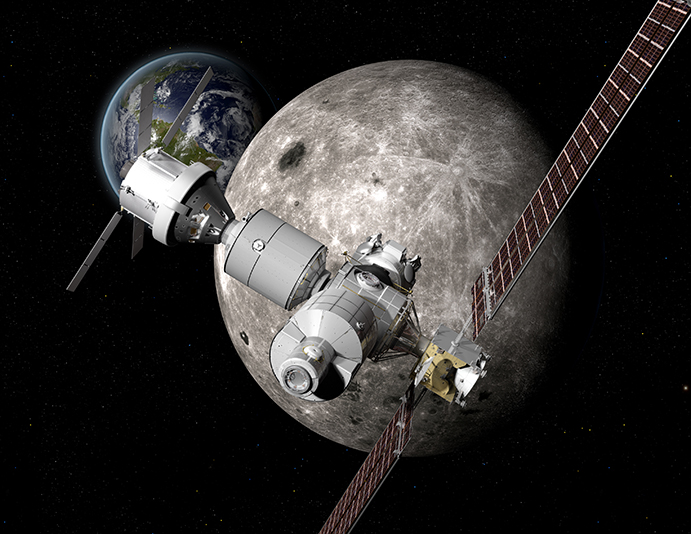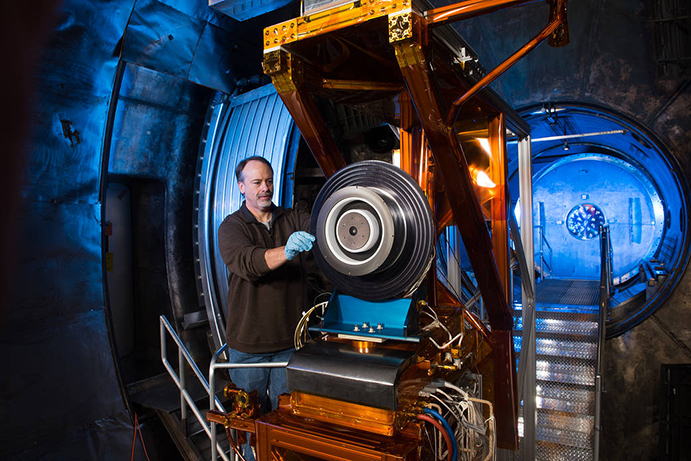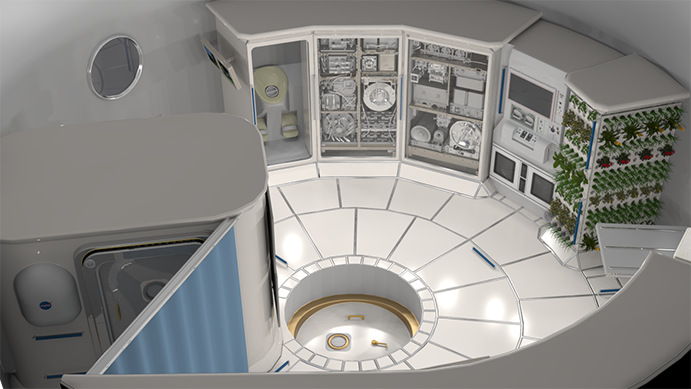Private companies are building prototypes for a planned Deep Space Gateway space station to prepare crews and develop equipment for missions deeper into the solar system
The time is now approaching for humanity to consider its next steps in space. For the
past two decades, manned spaceflight has revolved around the International Space Station (ISS), which has been continuously inhabited since 2000. But time is running out: after several life extensions, the ISS is currently scheduled to go out of service around 2024.
To acclimatise crew for the long durations in space required for deep-space missions, and to develop and test systems for long-duration spaceflight and the conditions distant from Earth, the solution being considered by NASA is a Deep Space Gateway (DSG). This will be a space station positioned in lunar orbit (sometimes referred to as cis-lunar space), around a quarter of a million miles from Earth and well outside the protection of the magnetosphere.

Ian Crawford, professor of planetary science and astrobiology at University College London, told The Engineer: “A cis-lunar habitat [between the Earth and Moon] will enable development of techniques for long-duration stays outside the Earth’s magnetosphere. It will also enable development of telerobotic operation of rovers on the lunar surface, and enable human-assisted sample return missions from the surface. Learning to operate for prolonged periods in deep space will certainly be required before it will be possible to send people to Mars.”
The DSG project moved into a higher gear towards the end of March, when President Donald Trump signed a mandate for NASA to undertake a crewed Mars mission by 2033. In response, NASA’s assistant administrator for human exploration and operations, William Gerstenmaier, made a presentation to the agency’s steering committee detailing plans for the project and indicating that six companies had been invited to design parts of a prospective space station, initially as ground-based prototypes.
Towards Mars
Gerstenmaier positioned the DSG as part of two larger projects: the series of missions to develop NASA’s space launch system (SLS), the enormous rocket based on Space Shuttle technology intended to launch missions beyond Earth orbit; and the Mars project. The first SLS launch, designated Exploration Mission-1 (EM-1), is currently planned for September 2018, and will send an uncrewed Orion capsule into lunar orbit to test its systems. Gerstenmaier envisages a further series of launches between 2018 and 2025 to ferry components of the DSG into lunar orbit where they will be assembled. NASA’s planned return to human Moon landings will use the DSG as a staging post.
Gerstenmaier conceives the DSG as being much smaller than the ISS, initially consisting of three module types: a power and propulsion bus (PPB), one or two habitation and laboratory modules, and a logistics module to service research. A spokesman from Boeing, one of the contractors hoping to build the DSG, said that these modules will contain advanced, next-generation systems suitable for deep-space operations: “Significant advancements in space technology have occurred since ISS was built and this latest technology will be used, resulting in smaller, more efficient systems. One very visible change will be the use of docking ports compliant with the new International Docking System Standard.”

NASA’s long-term Mars plan also involves the delivery of a Deep Space Transport vehicle to the DSG in 2027. This will dock with the DSG to check its systems, then undertake a crewed cis-lunar checkout voyage lasting about a year in 2028-29, followed by the mandated crewed trip to Mars – orbiting, but not landing – in the early 2030s, which would last about three years.
One important difference between the ISS and the DSG is that the DSG would not be crewed permanently. Although crews will stay on the station for extended periods, much of the systems testing can take place with nobody on board using remote sensors. While the ISS requires around a thousand instructions from the ground to remain in operation, the DSG will be far more autonomous. Gerstenmaier said in a NASA statement: “The gateway could move to support robotic or partner missions to the surface of the Moon, or to a high lunar orbit to support missions departing from the gateway to other destinations in the solar system.”
European collaboration
Also, NASA envisages collaboration with the European Space Agency on the power and propulsion bus and the habitat modules. ESA’s director of human spaceflight and robotic exploration, David Parker, told The Engineer that initial talks about the agency’s involvement in the project had already taken place. “The DSG is a concept that has emerged from discussions involving all the ISS partners, including ESA,” he said. “ESA has been studying the possibilities for European contributions for over a year and the three main prime industries are involved. Nothing has been decided so far, but possible technologies include the habitation module itself, electric propulsion, docking systems and life-support systems. For example, ESA will shortly test a new system aboard the ISS. The Advanced Closed-Loop System [ACLS] is a regenerative life-support system for closed habitats.”
Parker pointed out that the project should not be underestimated. “As the crew module would be much smaller than the space station, conditions would more spartan — making the human challenges a lot greater than today,” he said. “There are many technical challenges involved in sustained exploration, such as reducing the logistic supplies needed by increasing the efficiency recycling of consumables such as air and water; improving radiation protection; and maybe even using on-board manufacturing of spares using 3D printing.”
However, Parker also added a note of caution. “Any proposal to build elements for the DSG will require a decision of our participating states. Therefore, we have started discussions with them, but it is too early to say what the outcome will be. But this looks like an exciting opportunity to put Europe at the heart of deep-space exploration.”
Click here to read about the six NASA-funded projects to develop ground-based prototypes for the DSG
Life-support system poses a challenge

The head of ESA’s development and future projects division, Daniele Laurini, explained that providing the ACLS closed-loop life-support system for the DSG is a considerable challenge. “ESA has provided some open-loop environmental control and life-support systems [ECLSS] for the ISS’s Columbus module, but the ACLS is the first time we’ve launched a CO2 recovery system to partially close the air loop,” he said.
The ACLS will recover and purify water from the crew’s urine and condensed sweat, some of which will be used for drinking, while it will use electrolysis to convert anther portion of this into oxygen and hydrogen. The latter will then be used to convert exhaled CO2, which will be scrubbed from the air using a regeneratable solid amine, into methane and water; the methane can be safely vented from the station. “So far, NASA and Russia have done more than ESA in terms of air and water loop closure; Russia on Mir and NASA on Skylab,” Laurini said. “NASA currently recovers about 50 per cent of CO2 and 80-85 per cent of the water on the ISS; we’re hoping to improve on that.”
ACLS will be launched next February aboard Japan’s HTV-7 automated resupply mission and tested for about one continuous year in the US laboratory on the ISS, Laurini said. After that, it will be used as a back-up unit if there are more than four crew members on the non-Russian side of the station, or if the existing ECLSS is being maintained or fails.
Laurini also explained that while it would be possible for the DSG to use conventional chemical rocket thrusters for station-keeping and orbit adjustment, electrical propulsion units are lighter than chemical rockets and therefore offer an advantage in reducing launch mass.
The type of solar-electric propulsion proposed for the station – Hall-effect thrusters – use xenon gas as a propellant. It works by trapping electrons in a magnetic field; the electrons ionise the propellant gas, and the magnetic field accelerate the ions to eject them from the engine to generate thrust. This type of thruster produces constant acceleration and a higher impulse than the ion drives used for satellites and exploration vehicles in recent years, Laurini explained. “It is also a great opportunity to do long-duration testing for the thrusters that will support other exploration missions, including flights to Mars,” he added. However, Laurini believed that a Mars transport will use a combination of electric and chemical thrust.
ESA is currently developing a high-power Hall effect thruster, while lower-power ones have been under development and long-term testing in the US for some time, Laurini said. “The technology is there; what is tricky is to make it long-lasting and avoid erosion.”
ESA is currently developing a high-power Hall effect thruster, while lower-power ones have been under development and long-term testing in the US for some time, Laurini said. “The technology is there; what is tricky is to make it long-lasting and avoid erosion.”




Red Bull makes hydrogen fuel cell play with AVL
Formula 1 is an anachronistic anomaly where its only cutting edge is in engine development. The rules prohibit any real innovation and there would be...